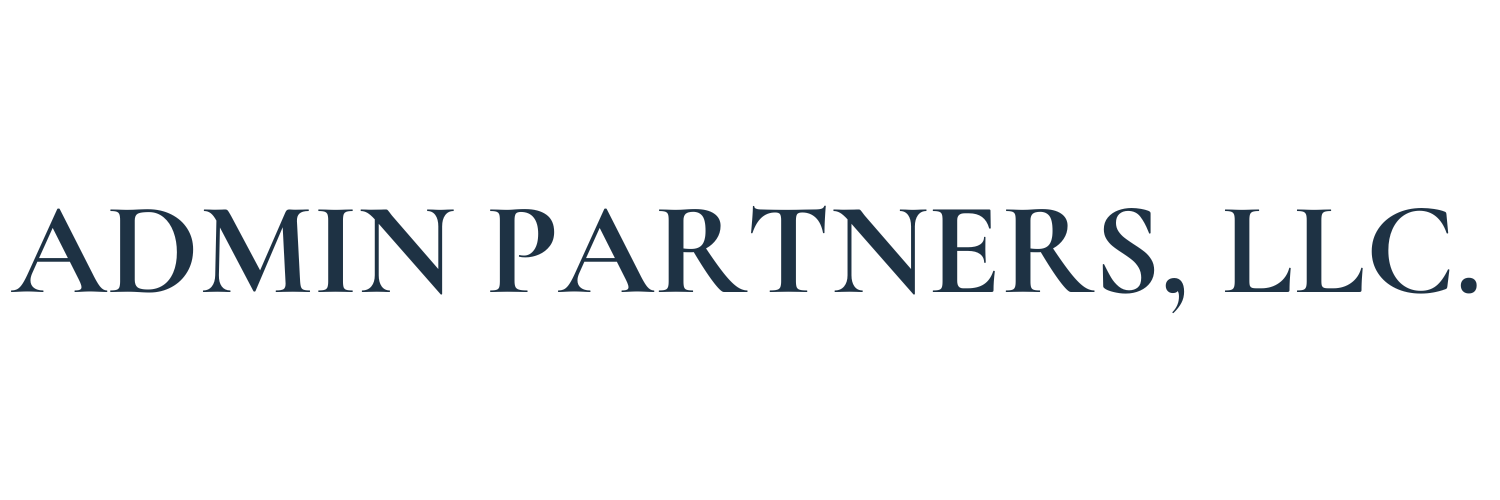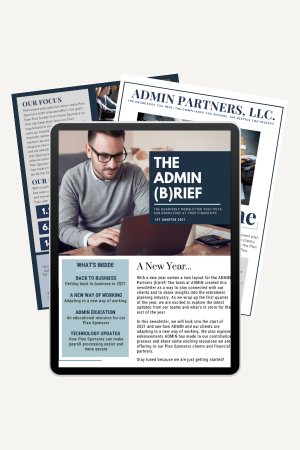
Do you have any questions for ADMIN Partners? Maybe you are ready to connect with us and receive a free consultation on your retirement plan. Use the form below to send us a message and someone from our team will contact you in the next 24-48 hours.
We can’t wait to hear from you!
Submit A Request
SERVICE@YOURADMINPARTNERS.COM
Call Us
877-484-4400 (9AM – 5PM EST)
General Questions
CONTACT@YOURADMINPARTNERS.COM
Frequently Asked Questions
What is a non-producing TPA?
You may have seen us refer to ourselves as a non-producing TPA, but what exactly does that mean? Unlike other Third Party Administrators, ADMIN Partners does not sell investment products nor do we offer investment advice. While your Financial Advisor representative provides you with education on investments, ADMIN keeps our focus on plan compliance and administration. We use our knowledge and expertise to work alongside over 60 investment providers to provide you with the ultimate retirement plan solution.
How much does it cost to work with ADMIN Partners?
Our fees vary based on the plan type, plan design, and the services we are providing to a client. To learn more about the service models offered by ADMIN Partners, you can view our Service Model comparison sheet here. You can also reach out to us directly to get a quote that is customized to your organization’s specific needs. To contact us, you can complete our Request A Quote form online, email us at sales@youradminpartners.com, or call us directly at 877-484-4400.
Why use a TPA vs. self-administering?
In 2008, regulations surround 403(b) retirement plans drastically increased and since then, legislation has continued to demand more from Employers. From plan document design, to administrative responsibilities and even ERISA obligations, there is immense pressure on Employers to keep their plans in compliance. Working with a TPA alleviates this responsibility from the Employer so there is more time to focus on your organization’s mission. With over a decade of industry experience, ADMIN’s team easily absorbs the administrative burden that comes with a retirement plan. To learn more about some of the services offered by ADMIN and how we can help your retirement plan remain compliant, download our Plan Services Sheet.
How does ADMIN support a plan in the event of an IRS audit?
The threat of an IRS audit exist for all retirement plans, both big and small. Over the years, ADMIN has seen a number of clients fall victim to an audit from the IRS. From failure to complete annual Universal Availability requirements to outdated plan documents to omitting, Employers can be penalized for a number of circumstances. These penalties can be costly to an organization. Fortunately, ADMIN is here to help! Our clients are supported by ADMIN’s team of experts in the event of an IRS audit. Our assistance includes written responses to IRS questions, data collection and if requested, ADMIN will provide a representative to accompany the client to the audit to discuss how the Plan is administered. To learn more about the threat of an IRS audit and how ADMIN supports our clients, check out our comprehensive blog posts on the topic: IRS Hot Buttons Part I and IRS Hot Buttons Part II.
How does a participant establish an account in a retirement plan?
Participants will work alongside their Employers and Financial Advisor(s) in order to establish an account with one (or more) investment providers approved within the Plan. Participants will use an Enrollment Form to establish the account with the investment provider and will then complete a Salary Reduction Agreement to begin making contributions from their paycheck.
What is the difference between an Enrollment Form and a Salary Reduction Agreement (SRA)?
Enrollment forms are used to establish an account with an approved investment provider within a retirement plan. A Salary Reduction Agreement (SRA) is used to initiate, change, or cancel salary reductions withheld from a participant’s paycheck and contributed to Plan on their behalf.
How does the SRA process work?
Once a participant has established an account with an approved vendor in the Plan, they will complete a Salary Reduction Agreement. This form should be provided directly to your Payroll/Human Resources representative so they can make the necessary deductions from you paycheck. Employers will provide a completed copy of the SRA form to ADMIN Partners for recordkeeping purposes..
How are contributions remitted from the Plan?
There are a few ways that Employers can submit contribution funds to ADMIN Partners:
ACH Push (Preferred): An ACH Push is an electronic method of sending money. Sending an ACH push for contribution remittance typically takes 24 hours to arrive at the bank. Clients prefer this method as it is a much faster and secure way to send money.
Federal Wire (Recommended): A Federal Wire is also an electronic method of sending money. Federal Wires are a real time submission of funds meaning that once the Fed Wire is sent from the sending bank, it arrives immediately at the receiving bank. Generally, Fed Wires are a more expensive method of sending funds, but some clients do prefer this method due to its immediacy and security.
ACH Pulls (Recommended): An ACH Pull is an electronic method of sending money. An ACH Pull is when the receiving bank requests an ACH debit or a pull from the sending bank. An ACH Pull is only initiated at the instruction of the client typically through an email that contains the debit amount and the debit date.
Checks (Not Recommended): While we do accept checks as a method of sending/receiving contributions, we do not recommend this method due to the large delay of getting employees retirement contributions invested at their respective investment provider. As checks have proven to be a slow, insecure, and an inefficient method of sending contributions, banks have started to move away from using checks as part of their standard operating procedures and prioritizing electronic methods of receipt.
How is contribution data remitted for a retirement plan?
ADMIN Partners encourages all of our remitting clients to submit their contribution data via our online web portal. Not only does the online portal allow Employers to submit their plan’s data with ease, but it also ensures that sensitive participant information is processed in a more secure environment. To learn more about our web contribution process, click here.
How can a participant make a withdrawal from their account?
The withdrawal options available to participants vary based on the provisions offered within their retirement plan. Once a participant has confirmed that their withdrawal request is allowed by their Plan, they can contact their investment provider to receive the required paperwork needed in order to review/fulfill their request. Completed paperwork will be provided directly to ADMIN Partners for review/approval.
How can a withdrawal request be submitted to ADMIN Partners?
Completed paperwork can be submitted to ADMIN Partners via email: Service@youradminpartners.com or by fax at 856-755-3515. NOTE: ADMIN Partners is currently finalizing an online portal that will allow withdrawal requests to be submitted online with ease! Stay tuned for updates.
What is ADMIN's approval process for withdrawal requests?
TRANACTION PAPERWORK: ADMIN’s role as a Plan Administrator (or an Information Coordinator for certain Plans) is to review, monitor and record plan transactions in accordance with the written plan document and all applicable IRC and DOL regulations. Please submit all investment provider forms and supporting documents to ADMIN for approval.
TRANSACTION REQUEST FULFILLMENT: The ADMIN Service team will submit approved participant transaction requests directly to the applicable investment provider(s) unless instructed differently by the participant or their financial representative. In the event a participant’s transaction paperwork is not in good order, or the request cannot be approved because it is contrary to the written plan document or applicable regulations, the ADMIN Service team will contact the participant directly indicating the reason the denial of the request.
APPROVAL PROCESS TIMING: For participants requesting review and approval of a compliance transaction received in “good order”, ADMIN will provide a determination to the participant within one (1) to three (3) days for our TPA clients, and two (2) business days for data aggregation clients. If we anticipate that the request for additional information will take longer than three (3) business days, a team member will notify the requesting party and the Employer about the delay.
Why does a withdrawal request need to go through ADMIN Partners?
Employers hire ADMIN Partners to keep their retirement plan in compliance and to alleviate the administrative responsibility that comes with the review and approval of withdrawal requests. Our team of experts supports Employers and their participants with these requests to ensure that withdrawals are done based on the provisions set forth in the retirement plan document.
How much does ADMIN charge to review/approve withdrawal requests?
ADMIN Partners does not currently charge transaction fees to participants or Employers for our compliance services. The cost for these services is built into our ongoing fees.
How do Employers make updates to their retirement plan & what is the cost?
ADMIN’s retirement plan clients are assessed an annual document maintenance fee (outline in our ongoing fees), so there is no additional cost for plan updates. To request a plan update, you can reach out to ADMIN’s Service Team by emailing us at Service@youradminpartners.com or by calling us directly at 877-484-4400.
What is ERISA?
The Employee Retirement Income Security Act of 1974 (ERISA) was established to protect retirement plan participants as well the investments that they contribute to their employer-sponsored retirement plan. This federal law was established to safeguard the interests of participants and beneficiaries by requiring the disclosure of all features & funding within the plan.
What subjects a plan to ERISA and what are the responsibilities that come with the title?
While there are some 403(b) plans that are statutorily exempt from the rules and regulations of ERISA (public education, government, and most church plans), there are many non-governmental plans who can become an ERISA Plan based on the following factors:
–Plans that are sponsored by private tax-exempt employers and make decisions on behalf of the plan (vesting, compliance provisions, employee exclusions, etc…) or receive compensation for performing administration.
–Plans that offer an employer match as an added benefit to the participants of the plan.
–Employers that use a group arrangement for participant investments versus individual contracts.
Some of the responsibilities that come with being subjected to ERISA include:
REPORTING: Plan administrators are held accountable through detailed reporting dur annually to the federal government: Form 5500 and Form 8955-SSA
PROTECTION: The law lays out how assets in retirement plans are protected and how plan participants can have grievances addressed.
PLAN PARTICIPATION: The law specifies anti-discrimination regulations on plan participation. For example, high earners often cannot contribute a significantly higher proportion of their salaries than low earners. this is known as nondiscrimination testing that happens annually.
FIDUCIARY STANDARDS: The law dictates that plan administrators act in employees’ best interests, not their own.
INFORMATION DISCLOSURES: All plan participants must be provided specific standardized information about their plans


